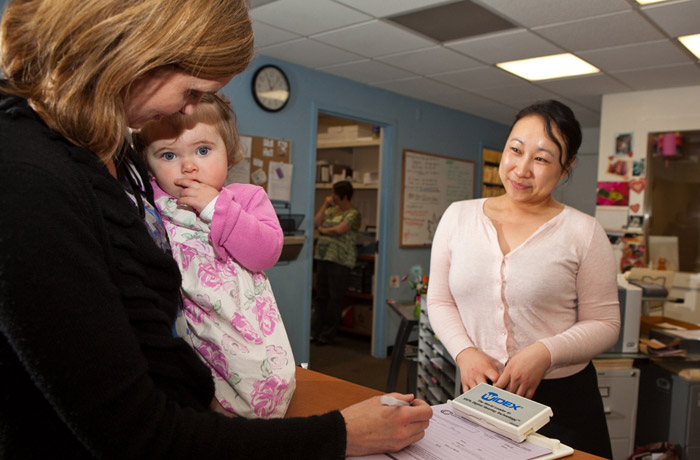Newborn Hearing Services
Newborn Hearing Testing
My Baby Didn’t Pass the Newborn Hearing Screening
Up to 10 percent of babies do not initially pass the newborn hearing screening, and most often for reasons unrelated to permanent hearing loss. Common reasons for not passing the screening include birth matter in the ear canal, fluid behind the ear drum, or movement and crying during testing. Many babies referred for re-testing will have normal hearing. However, it is extremely important that you follow-up with the recommended retesting, as it is the only way to ensure 1) that your baby does not have hearing loss or 2) confirm a hearing loss so that the appropriate referrals and recommendations can be put into place.
Screening vs. Diagnostic Evaluation

During a screening, the audiologist or screener is looking for a response from your baby’s ears is present while presenting a set, predetermined level of sound. The response is either there (pass) or not (fail). During a diagnostic evaluation, the audiologist varies the levels and the pitch (i.e. low, mid, high) of the sounds and is therefore able to estimate much more specifically what your baby can and/or cannot hear. It is for this reason that a screening might take just 30 minutes while a diagnostic evaluation is likely to take approximately 2-4 hours.
Hearing Tests for Infants
Prior to test day, you should receive a packet in the mail with information about Preparing for Your Infant’s Hearing Screening/Test. Please read the information sheet carefully, as it includes tips for making the testing process easier on both you and your baby! Below are the tests that are used to assess your baby’s hearing. Please note that not all of the tests listed here might be performed during your appointment, as it will depend on if your baby is being seen for re-screening or diagnostic evaluation:
- Otoscopy: A visual examination of the ear canal and ear drum using a lighted device called an otoscope.
- Tympanometry: A probe is placed in the ear canal to record movement of the ear drum, which is used to identify middle ear dysfunction (e.g., fluid behind the eardrum).
- Acoustic Reflexes: The same probe for tympanometry is used to measure a middle ear muscle reflex response to loud sounds.
- Otoacoustic Emissions: A probe is placed in the ear canal to measure the inner ear’s response to sounds.
- Auditory Brainstem Response*: Electrodes are placed on the forehead and behind the ears to measure the brainstem’s response to sounds. The audiologist uses these responses to estimate what the baby can and/or cannot hear – different pitches and different loudness levels.
- Behavioral Observation Audiometry: The audiologist looks for certain behaviors from the baby, like startling in response to loud sounds. The sounds are presented either through tiny insert earphones or speakers in a sound booth.
After testing is complete, the audiologist will be able to describe the status of your baby’s hearing. If hearing loss is indicated, you will be given full information regarding appropriate steps for follow-up. You will also be referred to our family counselors and FACES team for full support.
*Please note that the Center does not perform sedated ABR testing. We perform sleep-deprived ABR testing with responses collected in a natural sleep condition. Therefore, we usually only schedule ABR evaluations for infants up to age six months.
